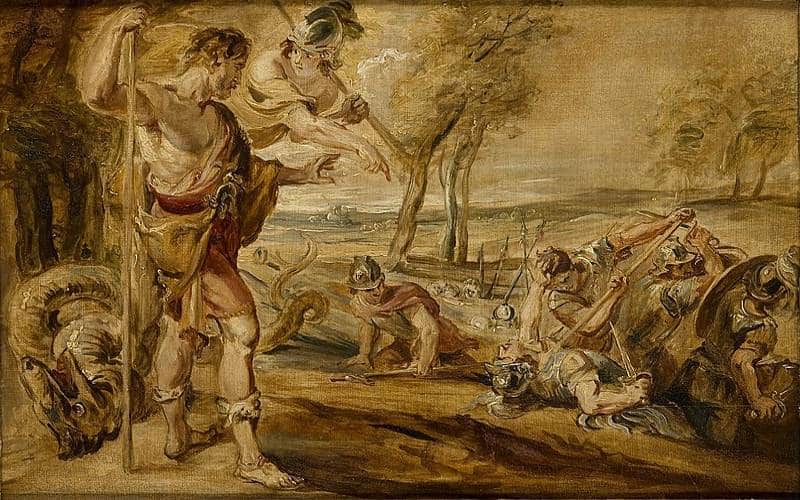In Greek mythology, the Spartoi were a group of legendary warriors who were said to have emerged from a dragon’s teeth sown in the ground. These warriors were known for their bravery and fighting abilities, and they frequently appeared in various myths and legends, such as those from Thebes and Colchis. Let us delve deeper into the fascinating world of the Spartoi, discovering their stories and connections to Cadmus and Jason.
Spartoi Key Facts
| Parents | Dragon’s teeth sown into the ground |
| Partners | Unknown |
| Siblings | Other Spartoi |
| Offspring | None |
| Other names | None |
| Greek name | Σπαρτοί |
| Roman name | Spartoi |
| Best Known Myths | Birth from Dragon’s Teeth by Cadmus and by Jason |
Name and Etymology
The name “Spartoi” is an adjective/participle derived from the Greek verb σπείρω. In Ancient Greek, the verb σπείρω had two meanings: literally sowing (i.e. crops) and procreating. Thus, the Spartoi were the ones who sowed or born through sowing.
Spartoi’s name reflects the uniqueness of their story, as they were created by sowing a mythical dragon’s teeth in the ground. They had no other names, and both Greeks and Romans referred to them as “Spartoi.”
Apollodorus has given us the names of the famous Spartoi. These are:
- Chthonius (Χθόνιος) = of the Earth
- Echion (Ἐχίων) = of the Viper
- Hyperenor (ϓπερήνωρ) = Overbearing
- Pelorus (Πέλωρος) = Gigantic
- Udaeus (Οὐδαῖος) = of the Earth
Spartoi Family and Relationships
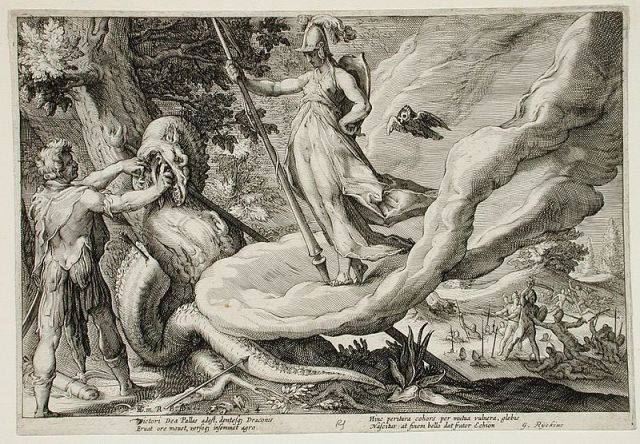
The Spartoi were sown from the ground, so there is no clear parentage other than being born from a Dragon’s teeth. In that regard, the Dragon could be considered their parent. We could also identify the people who sowed the Dragon’s teeth, namely Cadmus and Jason.
Since Dragon Ismenios, a son of Ares, guarded Ares’ spring near Thebes, the Spartoi could also be considered descendants of Ares, the god of war.
Some of the Spartoi went on to have families of their own. According to Apollodorus, Chthonius had two sons: Nycteas and Lycus. Echion had a larger role in Greek mythology because he married Agave and had a son, Pentheus, and a daughter, Epirus. We will go over their history below.
Myths about Spartoi
The Death of Dragon Ismenios
The Dragon Ismenios was a son of the god Ares. The Dragon, a venomous snake according to Ovid’s Metamorphoses, was tasked with guarding Ares’ spring in Boeotia. His name, Ismenios, comes from the Naiad nymph Ismene, whose spring he was guarding.
Cadmus, the son of King Agenor and Queen Telephassa of Tyre, was tasked with finding and returning his sister Europa, whom Zeus had kidnapped. However, when he sought assistance from the Oracle in Delphi, he received another prophecy. Cadmus had to abandon his father’s quest and establish his own town. The location of the town would be determined by a cow; wherever the cow rested, Cadmus would build a new city.
The cow led him to the site where Thebes was to be founded. After sacrificing the cow to the goddess Athena, he attempted to find fresh water at a nearby spring. Little did he know that it was Ismene’s spring, guarded by the Ismenian Dragon.
The Dragon killed all of Cadmus’ men, but the hero was able to defeat the serpent. That act would pave the way for the legendary town of Thebes, at the expense of Cadmus. He had to serve God Ares for eight years and, according to some accounts, would be transformed into a serpent when he died.
Cadmus and the Spartoi
After Cadmus killed the serpent, the goddess Athena instructed him to separate the dragon’s teeth into two piles. Athena took half the teeth and told Cadmus to sow the other half in the ground.
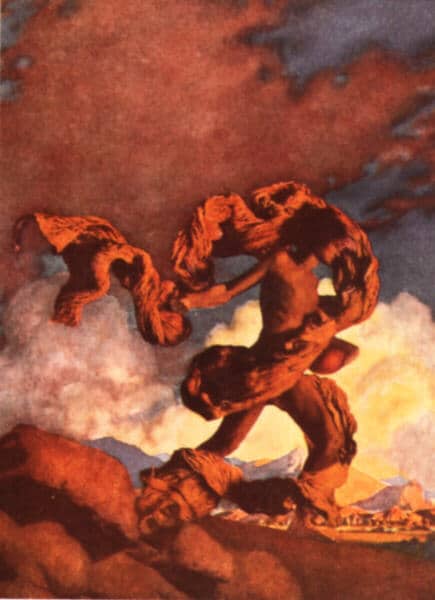
Cadmus obeyed the orders of the goddess Athena, but something unexpected occurred. Each tooth he sowed produced a fully armed warrior. Cadmus was afraid they were going to attack him, so he threw a stone between them.
The Spartoi began to fight each other because they believed the stone was cast by another Spartos. Finally, only five remained: Chthonius, Echion, Hyperenor, Pelorus, and Udaeus. According to Seneca and Statius, the ghosts of the Spartoi haunted Thebes’ sacred Ares field.
Of course, Ares had to punish Cadmus for murdering his protector. He enslaved Cadmus for eight years to atone for his sin. Following that, Cadmus married Harmonia, the daughter of Ares and Aphrodite. Some accounts describe how, at the end of their lives, both were transformed into serpents.

The Spartoi in Thebes
Echion was regarded as the leader of the remaining five Spartoi. They would go on to play an important role in the formation of Thebes, as well as in determining its future course.
Creation of Thebes
The Spartoi who remained dropped their weapons and agreed to help Cadmus build the city he wanted. The city was named Cadmea after its founder. After several generations, the city was renamed Thebes.
Cadmus and Harmonia became Thebes’ first royal couple, and they had one son, Polydorus, and four daughters, Agave, Autonoe, Ino, and Semele. These individuals contributed significantly to the infamous Theban curse.
Aside from the royal family, the five Spartoi would establish five noble houses in the town of Thebes. All future generations of Thebans would be descended from Cadmus or one of the Spartoi.
Echion and Pentheus
Echion, leader of the Spartoi, ended up marrying Agave, daughter of Cadmus. They had a son, Pentheus, who became king of Thebes. That happened because Polydorus, son of Cadmus and Harmonia, was not yet of age.
According to Euripides’ Bacchae, Semele, daughter of Cadmus, had slept with Zeus and had bore Dionysus. Her sisters, Agave, Ino and Semele did not believe that. That led to Dionysus being enraged with them, turning the women of Thebes into his followers. Pentheus, while he couldn’t accept that the women were roaming free, following Dionysus, tried to stop them. He ended up being dismembered by his own mother in a feat of divine frenzy. That would be the first step in the curse of Thebes.
Descendants of the Spartoi
After the murder of Pentheus, Cadmus’ son, Polydorus, ascended to the throne. Following his death, the throne was passed down to Chthonius’ sons.
Nycteus was entrusted with the governance of Thebes after the death of Polydorus. However, his brother Lycus usurped the throne and held it for 20 years.
During his reign, the Thebans campaigned against and subjugated Sicyon, and Lycus is said to have assassinated King Epopeus and imprisoned his wife Antiope, who, as Nycteus’ daughter, was his niece.
Dirce, Lycus’ wife, tortured Antiope during her detention, but her sons Amphion and Zethos retaliated, killing the usurper and his wife when they seized power in Thebes.
Following Lycus’ death, Labdacus, son of Polydorus and Nycteis (daughter of Nycteus), ascended to the throne. He was said to have been disparaged, like Pentheus, for disrespecting Dionysus. He died young, leaving only one son, Laius, the father of Oedipus. Other notable descendants include Creon, Polynices, Eteocles, Antigone, and Ismene.
According to Pseudo-Hyginus, all the descendants of the Spartoi bore a birthmark in the shape of a spear.
Jason and the Spartoi
We’ve already covered the story of Theban Spartoi. As previously noted, Athena had taken half of the Dragon’s teeth. What happened to these teeth?
Aeetes, King of Colchis, received the Dragon’s teeth as a gift from Athena. When Jason and his Argonauts arrived in Colchis on their quest for the Golden Fleece, Aeetes assigned them several deadly tasks to complete first. One of the tasks involved the dragon’s teeth.
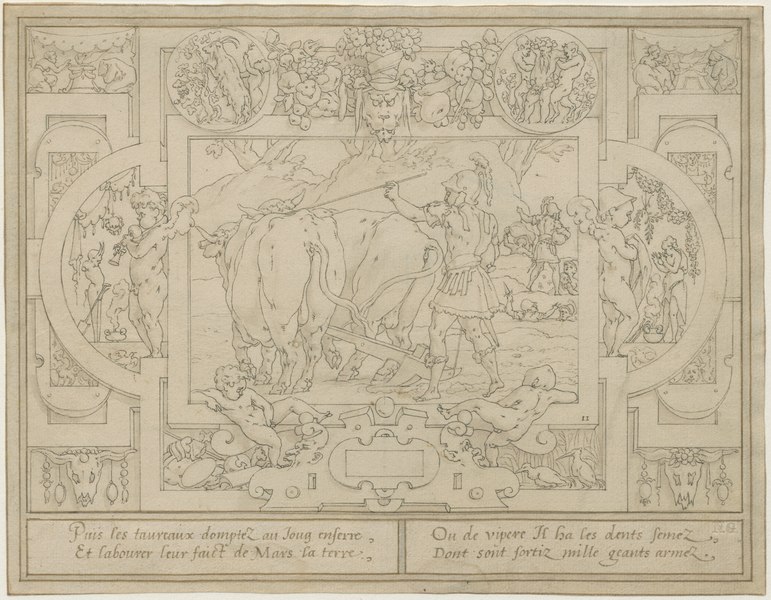
Jason was specifically instructed to plow a field by yoking two massive bronze bulls that breathed fire, known as the Khalkotauroi or Colchis Bulls. After that, he was told to sow Dragon’s teeth in the plowed field.
When the Spartoi began to appear, Jason knew what to do because sorceress Medea, daughter of Aeetes, had instructed him how to deal with them. So, he threw a rock among them, and the Spartoi began killing each other, just as they had in Thebes. In this story, however, Jason dealt the final blow to those who remained alive and was the sole survivor.
Depiction And Characteristics
The Spartoi were frequently depicted as fierce, armored warriors preparing for battle. They were well-known for their bravery and combat abilities, making them formidable opponents on the battlefield.
Symbols associated with the Spartoi include dragon’s teeth and armor, reflecting their unique origin and warrior status.
Representations Of Spartoi in Art
The Spartoi have been depicted in a variety of works of art, most commonly as fierce warriors engaged in battle. Other works of art include Cadmus and Jason sowing the Dragon’s Teeth.
Some of the paintings that depict them are:
- “Jason and the Golden Fleece 11: Jason ploughing the earth and sowing the dragon’s teeth” by Leonard Thiry (ca. 1500–ca. 1550)
- “Cadmus and Athena” by Jacob Jordaens (1600s)
- “Cadmus Sows the Dragon’s Teeth Which Turn into Armed Men” by Hendrik Goltzius (1615)
- “Cadmus sowing dragon’s teeth” by Peter Paul Rubens (1600s)
- “Cadmus Sowing the Dragon’s Teeth” by Maxfield Parrish (1908)
Mentions in Ancient Texts
Apollodorus’ Bibliotheca (2 AD)
The work of Apollodorus contains the majority of the information about who the Spartoi were and who remained, as well as the noble houses of Thebes. Apollodorus also provides information about Jason and the Spartoi of Colchis.
Ovid’s Metamorphoses (8 AD)
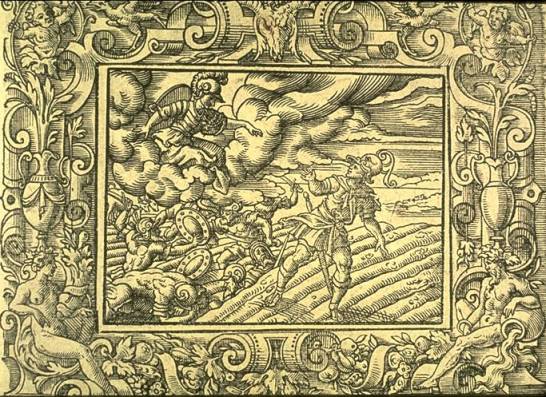
Virgil Solis, Public domain, via Wikimedia Commons
In his epic lyric poem, Ovid tells the story of Cadmus and the birth of the Spartoi from the dragon’s teeth. The poem delves into themes of bravery, conflict, and the effects of divine intervention in mortal affairs.
Aeschylus’ Seven Against Thebes (5 BC)
In his famous tragedy about the civil war in Thebes, Aeschylus discusses the descendants of the five Theban Spartoi and their role in the political life of Thebes.
Frequently Asked Questions
The Spartoi warriors were said to have been born from the dragon’s teeth sown into the ground by Cadmus, resulting in their fierce and armored appearance. Some Spartoi were also spawned in Colchis from teeth sown by Jason.
By a misunderstanding triggered by Cadmus throwing a stone among them out of fear, the Spartoi believed they were being attacked by each other and engaged in a brutal conflict.
Athena played a critical role in providing Cadmus with the dragon’s teeth and instructing him on how to sow them to produce Spartoi warriors.
After the intense battle among the Spartoi, only five warriors – Echion, Udaeus, Chthonius, Hyperenor, and Pelorus – emerged alive from the chaos.
As recompense for his actions, Cadmus was forced to serve Ares, the god of war, for eight years before finally being granted Harmonia as his wife, the daughter of Aphrodite and Ares.
The surviving Spartoi, led by Echion and the others, assisted Cadmus in the founding of the city of Thebes after the conflict that ensued from their unique creation.
Featured Image Credit: Workshop of Peter Paul Rubens, Public domain, via Wikimedia Commons

